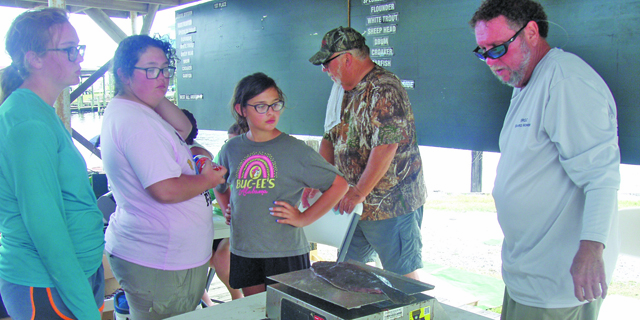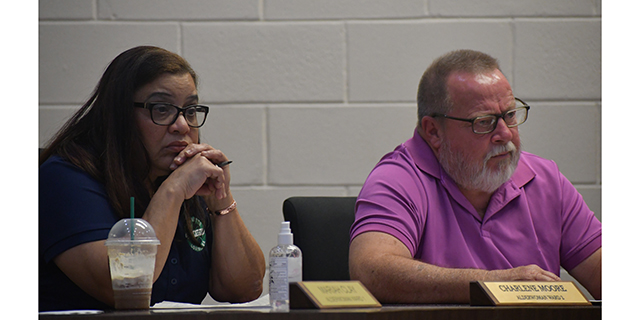All in a night’s work … 1,900 ducks banded at Rockefeller
Published 12:30 pm Tuesday, January 21, 2025
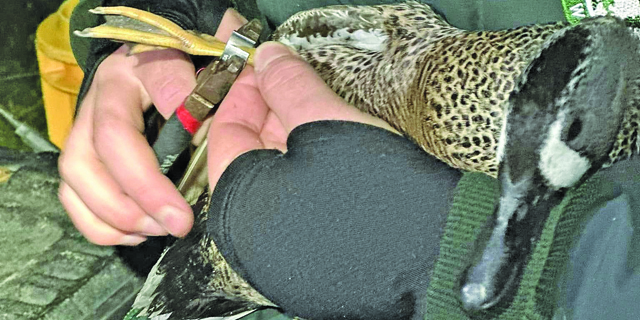
- A Louisiana Department of Wildlife and Fisheries biologist crimps a band on a duck after sunset Jan. 11 on the Rockefeller Wildlife Refuge. Approximately 30 volunteers from Lake Charles to Lafayette worked with Louisiana Department of Wildlife and Fisheries personnel to band and release 1,900 ducks. facebook.com
As the sun approached the horizon on a chilly Saturday night, the table was set, literally, for ducks in the marsh at the Rockefeller Wildlife Refuge.
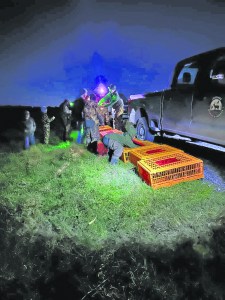
Louisiana Department of Wildlife and Fisheries personnel and volunteers banded 1,900 ducks Saturday night, Jan. 11, at Rockefeller Wildlife Refuge. Blue-winged teal, green-winged teal and spoonbills were lured by food to a limestone pad just before dark. Nets propelled by rockets were launched to capture the ducks, which were gathered by volunteers and placed in cages to be banded.
facebook.com
When the ducks, mostly teal, descended to eat food Jan. 11 on the limestone pad in place for a banding project undertaken by the Louisiana Department of Wildlife and Fisheries, nets were launched into the air to entrap the maximum number of feeding ducks on terra firma, where they could be extracted carefully by biologists and a couple dozen volunteers. The migratory birds were banded with aluminum alloy bands, then released into the night.
Long-time Ducks Unlimited member and former Louisiana DU state chairman Jay Owen of Lafayette participated as a volunteer in his fourth banding project along Louisiana’s Gulf Coast. He said he experienced a “phenomenal time” assisting in a vital conservation effort.
“You know, there’s a lot of information gained through banding programs. They’re gathering a lot of data on where birds move, why they move and everything else (such as harvest data, which is important for establishing duck hunting seasons and limits). We’re learning so much about patterns and migration,” Owen said.
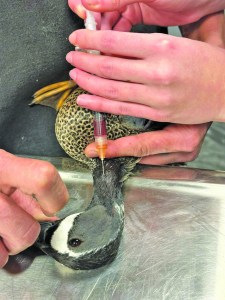
Some ducks banded Jan. 11 on Rockefeller Wildlife Refuge also had blood withdrawn at the lab on the refuge by Louisiana Department of Wildlife and Fisheries personnel. The blood preferably is collected from either the jugular vein or the metatarsal vein. The amount is based on the size of the bird.
facebook.com
Some of the ducks also were delivered to a lab on the refuge, where University of Georgia College of Veterinary Medicine researchers participating in the Southeastern Cooperative Wildlife Disease Study also tested the birds for Avian flu, a disease caused by the influenza-A virus, which primarily affects birds but can sometimes affect mammals, including people. Wild aquatic birds are the primary host of the virus.
Owen said 1,900 blue-winged teal, green-winged teal and spoonbills were banded and/or sampled. He emphasized the whole process for each bird from start to finish took no more than 4 hours, including delivering some of the ducks to the refuge’s lab for samples via blood collection and swabs, mostly to test for Avian flu strains circulating across the U.S.
“All the birds were captured, sorted, banded and released within three, four hours,” he said.
Paul Link, LDWF Coordinator for the North American Waterfowl Management Plan who works out of Rockefeller Wildlife Refuge, was in charge of the banding project. Various waterfowl agencies across the country attach the bands with an engraved number that contains information about banding location, age and sex, all critical to conservation efforts to determine migratory patterns and survival rates.
Owen, 61, has devoted nearly half his adult life to wildlife conservation as a volunteer. Since 2005, when he joined the Ducks Unlimited ranks, he has served on the local, state and national levels, including the board of directors.
He was named senior flyway vice-president of DU’s Region 4, which includes Kentucky, Tennessee, Arkansas, Mississippi, Alabama and Louisiana, in September 2023.
The outdoorsman showed he practices what he preaches on Jan. 11. The first vice president of investments for UBS Financial Services, where he has worked for 29 years, was among the volunteers who helped retrieve ducks from rocket-propelled nets (starting at the outside edges), sort them by species, hand them to four banders and get them back in the wild as soon as possible to live the life of a wild duck.
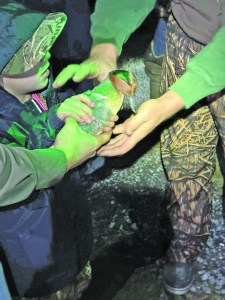
A young boy and another volunteer hand a green-winged teal to a Louisiana Department of Wildlife and Fisheries biologist during a banding project Jan. 11 at Rockefeller Wildlife Refuge.
facebook.com
Twenty-five to 30 volunteers joined forces with Owen, Link and other LDWF staffers for an evening with hundreds of migratory birds in the marsh of southwest Louisiana. Owen said he personally “handled a few hundred birds.”
“All blue-wings, green-wings and a few spoonbills. Other birds (ducks) won’t go up on land to feed like that. These birds would come in there. They were high-density. It was incredible.” he said.
“I absolutely love it … getting out there and being part of research of migratory birds is just phenomenal. I can’t give enough kudos to LDWF, what they’re doing down there and across the state.”
He noted that volunteers were instructed beforehand how to handle the ducks properly.
“Well, they are wild animals. They’re scared. They instruct you how to handle them. Things to do where you do not harm them,” he said.
Owen wasn’t the only past Ducks Unlimited state chairman for Ducks Unlimited on the site that cold Saturday night. Another volunteer who does more than talk the talk was Mickey McMillin of Moss Bluff, who worked shoulder to shoulder with outdoorsmen, outdoorswomen and boys and girls lending a needed helping hand.
Like Owen, McMillin has been with DU for many years, in many capacities. The former Louisiana DU state chairman and current president of DUMAC (Ducks Unlimited de Mexico AC) helped organize the volunteer work that night.
Another volunteer getting his hands on the hundreds of ducks was Chad Courville of Lafayette, whose daughter also volunteered to help. Courville, land manager for the Miami Corp., served as chairman and vice-chairman of the Louisiana Wildlife and Fisheries Commission in the mid-2010s, plus was chairman of the Louisiana Alligator Advisory Council.
Courville, who previously served as vice chair, is a lifelong Louisiana resident, also is a member of the National Wild Turkey Federation, Ducks Unlimited, the Coastal Conservation Association and the Louisiana Association of Professional Biologists.
LDWF will continue to band different species of ducks until April, Owen said.
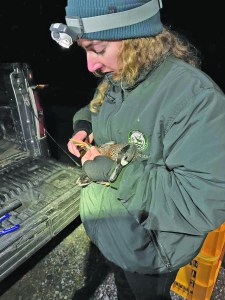
A Louisiana Department of Wildlife and Fisheries biologist cradles a duck while crimping a band on one of its legs Jan. 11 at Rockefeller Wildlife Refuge.
facebook.com
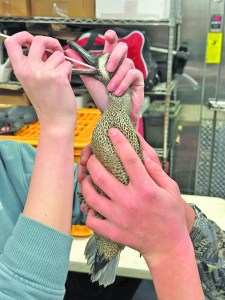
Some ducks captured during a banding project the night of Jan. 11 also were taken to a lab on the refuge to collect samples to detect Avian flu. Two Louisiana Department of Wildlife and Fisheries staffers take a tracheal swan sample by holding the mouth open and carefully swabbing the trachea and also along the choanal slit on the roof of its mouth.
facebook.com
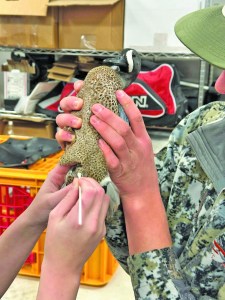
A duck captured Jan. 11 after sunrise during a banding project on Rockefeller Wildlife Refuge is swabbed by Louisiana Department of Wildlife and Fisheries personnel at a lab on the refuge. Waterfowl typically shed AI viruses in their fecal secretions, so a cloacal swab is the primary source of virus detection from ducks and geese. Both tracheal and cloacal swabs are recommended for testing purposes.
facebook.com


